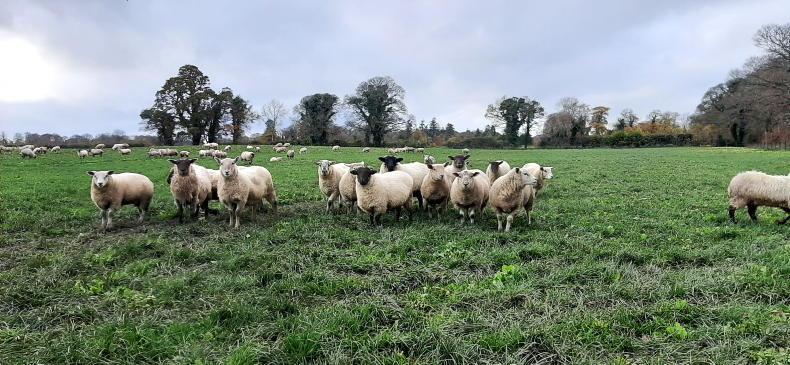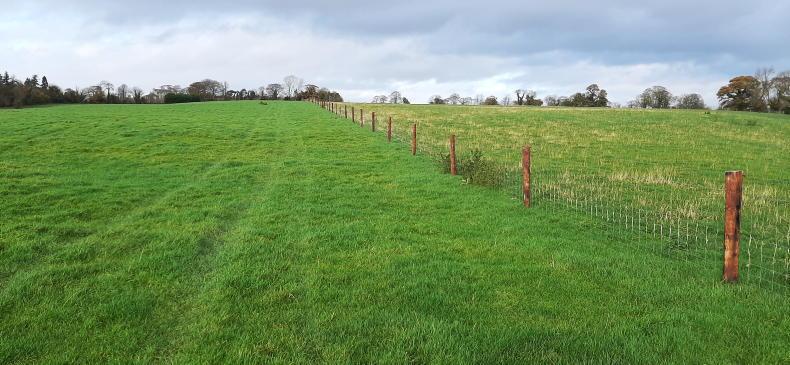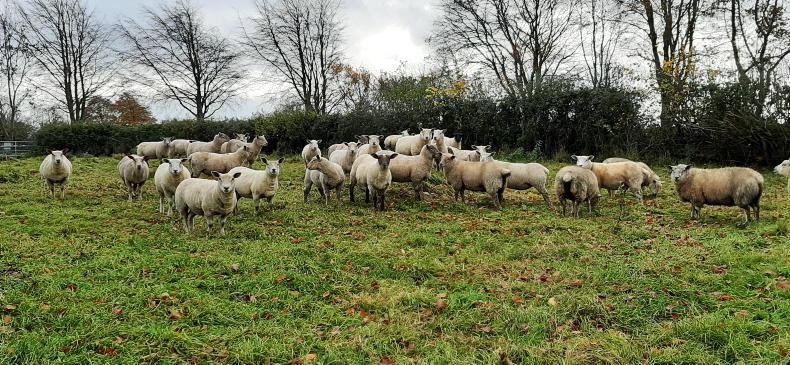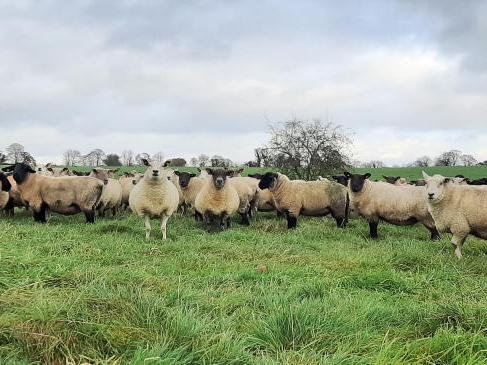There are numerous sheep production blueprints available that have been developed on the back of robust research or systems modelling.
These plans provide farmers with valuable information on how changes can influence their system at farm level.
Each farm is different and the success of these blueprints is often how they can be incorporated at farm level and intertwine with the farm’s resources such as land type, facilities present and labour availability, to name a few.
Moyglare Farm in Maynooth, Co Kildare, is owned by Sean Doyle who runs Sean Doyle Auctioneering Ltd.

Michael Hynes, manager, Moyglare Farm.
The farm has been managed in recent years by Galway native Michael Hynes, who has extensive experience managing farms in the UK and Ireland. During this time frame, Sean and Michael have implemented sizeable changes to the farming system.
Store lambs were purchased for finishing in the past, but this system has given way to a significant increase in ewe numbers.
This figure currently stands at 650 lowland ewes, 300 Scottish Blackface ewes and 150 ewe lamb replacements run across approximately 85ha (210 acres) of owned land and 15.5ha (38 acres) of rented land.
There is also notable ongoing changes in improving the farm’s grassland productivity, while a substantial change to the direction of the farm’s breeding policy came with the decision to finish purchasing store lambs and incorporate a hill flock to breed future replacements.
Hill sheep enterprise
Michael says the move to Scottish Blackface ewes was taken for a number of reasons.
There was a focus on increasing the stocking rate quickly and the practicality of going out and purchasing a couple of hundred lowland ewe hoggets was not a runner given the effect it would have on restricting the farm’s cashflow.

The flock of Scottish Blackface ewes is a relatively new venture aimed at increasing output and flock maternal characteristics.
With numbers increasing, there was also a focus on trying to keep the labour input in check and the move to Scottish Blackface ewes was viewed as not putting excessive pressure on the system with these ewes lambed outdoors.
Using this flock to breed replacements was also viewed as a means to incorporate maternal genetics into the main flock and also reduce the mature weight of ewes which had been trending upwards.
The farm has its third crop of Scottish Blackface ewes on hand and Michael says the system has worked relatively well, with a few notable learnings already evident.
Aged ewes are purchased from the same source each year, with some full- and broken-mouth ewes and the stipulation that all are suitable for breeding. The ewes are typical of the Mayo Connemara strain of Scottish Blackface, with a mature weight in the region of 50kg to 60kg.
One-year retention
An all-in, all-out system is practised whereby ewes are purchased in September and all are sold the following August. According to Michael, this is an important component to stick with.
“The first year we purchased ewes, we went through them at the end of the season and pulled out some for keeping that reared good lambs and were still fresh looking with a good mouth. However, these ewes tended to be the ones that gave problems in the second year and it proved to be a bridge too far.

A snapshot of a small percentage of remaining lambs on the farm.
“For me, the success of the system is getting one more year out of them in a lowland setting.”
Michael says you also have to be prepared to possibly accept a higher level of ewe mortality. “We have ranged from 6% to 8% mortality in ewes, but you have to be prepared that it could rise to 10% in the Scotch ewes, especially if they are not looked after from the start and preventative health treatments are limited.”
Reducing stress
Ewes come on to the farm at the start of September, are allowed to settle for a fortnight and are then dipped. They also receive a quarantine treatment for liver fluke, with faecal egg sampling influencing decisions around treatment for rumen fluke.
The Scottish Blackface ewes are run as a separate flock and do not mix with lowland ewes as a disease control health policy. Michael thinks that letting the ewes settle for a couple of weeks is important in preventing issues which may spike with stress.
“It is a big change of environment for these ewes coming from a hill enterprise where interaction with the farmer is likely to be low and there is an expansive grazing area to then being confined to a smaller grazing area and possibly having interaction with a farmer every day.

Fencing carried out under TAMS is improving the farm's infrastructure and grassland productivity.
“I find that if you give them two weeks after arriving and the initial health treatments are given and try to handle as little as possible from there, it allows sheep to settle easier.”
Scottish Blackface ewes have been mated with Texel, Charollais and Suffolk sires in recent years with the preference where retaining replacements to select Hiltex (Texel-cross-Scottish Blackface) ewe lambs.
This year, the farm has progressed down a slightly different breeding route, with two Texel-cross-Bluefaced Leicester hogget rams purchased from Padraig Stack in Kildalkey.
The reasoning for progressing down this route is two-fold, with the hope of adding more prolificacy to the mix from the Bluefaced Leicester, but still retaining the better finishing and lamb conformation attributes of the Texel.
The farm is operating four different lambing dates to make the best use of available facilities, while also generating balanced cashflow across the year.
First lambing date
The first lambing date of 28 December is also a relatively new venture for the farm and includes a small number of pedigree Charollais and Suffolk ewes, along with 75 commercial ewes.
The selection of these commercial ewes is random, with the ram effect used to stimulate the onset of cyclicity at the appropriate date by a number of rams being added with a batch of 300 ewes for a few days.
This typically yields in the region of 75 to 80 ewes lambing over the space of a week.
The next lambing date of approximately 200 ewes starts on 20 January and, again, no sponging is used, with the ram effect utilised to synchronise breeding.
A Hampshire Down ram was also added to the ram team this year for the early lambing flocks to trial its merit as a sire capable of reducing the time from birth to slaughter.
Another batch of 300 ewes lambs from 1 March onwards, including a small portion of horned ewes, with the aim of delivering a selection of heavier ewe lambs which may be suitable for breeding as yearlings.
The final breeding date is 20 November to give a lambing date of about 15 April. This includes the majority of Scottish Blackface ewes, ewe lambs and a selection of ewes which had their breeding date delayed to allow extra time to meet body condition score targets at mating. The timeline for this breeding is tight at about four weeks to prevent the lambing spread running on too long.

A selection of the strongest ewe lambs which will hopefully lamb down as yearlings.
Having such a drawn-out lambing spread would be a disaster for some flocks in terms of management, but Michael explains it works well on the farm.
“It can be strange alright to be lambing ewes in the morning and then turning around and heading to Irish Country Meats in Navan with finished lambs in the afternoon, but it works for us.
“The management groups are big enough that it doesn’t hamper the efficiencies of having animals at a similar age for health treatments and in a big enough batch for grazing management. The groups are all big enough in their own right to manage as a unit.”
The aim with the earlier lambing flocks is to try and scan upwards of 1.75 lambs per ewe joined and hit in the region of 1.85 to 1.95 lambs per ewe joined with the March lambing flock. The target in the Scottish Blackface ewe flock is 1.4 lambs per ewe joined.

Temporary fencing used to strip-graze deferred grazing.
“Essentially, our target is to try to sell an average of 1.5 lambs from every mature ewe bred. This may seem like a low figure, but where you are dealing with such a large number of ewes and have a sizeable hill ewe flock, then it is challenging to achieve this.”
The two earlier batches of ewes involve high-input systems, which rely on the use of concentrates to finish lambs. Michael says having these lambs out of the system early is vital in reducing grass demand as the season progresses. A quick review of lambs sold to date shows the average price at €118, with the cost of meal working out in the region of €10 (Redmills Lamb Creep Feed No 2) per lamb sold.
The farm has also had a much greater focus on grassland management in recent years, with a plan in place to improve grazing infrastructure and sward productivity.
There has been a large degree of fencing carried out under the Targeted Agricultural Modernisation Scheme (TAMS), with both new boundary and strategic internal fencing erected. This is feeding into a rotational grazing system and also providing the potential to temporarily split fields.
A reseeding programme incorporating the under-sowing of Tyfon with grass has worked relatively well in recent years in helping to reduce concentrate input and aid higher performance in lambs born in the March- and April-lambing flocks.
Drop in performance
Michael says the farm is open to change if any aspect is not working, citing a drop in performance of lambs transferred on to Tyfon from grass and concentrates as a lesson that will influence management in the future.
“This year, with grass supplies being tight due to a lack of rainfall during the summer we supplemented batches of mid-season lambs to underpin performance.
“When growth lifted, the crop of Tyfon took off and we put higher numbers on it to stop it getting too strong.
“We cut meal feeding to encourage a higher intake of Tyfon, but the change in diets took lambs a while to adjust to and we ended up losing a few weeks’ performance.
“We quickly got back on track and it is these little aspects that you learn from and put plans in place to avoid down the line.
“In the long term, the aim looks to be to continue to push the early batches of lambs with high-quality grass and concentrate supplementation, while focusing on driving performance from later-born lambs from grass and forage crops, along with strategic use of concentrates.”
Deferred and temporary grazing
Deferred grazing also played a part this year in sustaining early lambing ewes outdoors for longer. Sheet netting and strip block grazing was used to optimise utilisation and this is a practice that will be repeated in future years.
Availing of temporary grazing is also a significant plus for the system, with a large component of the farm still in permanent pasture and pressure coming on supplies in the shoulders of the year.
This will be improved as more reseeded ground comes on stream, while, with such a high demand for grass early in the year, it is critical that fields are closed up in adequate time in autumn and winter.
Michael is pleased with how growth has been this back-end, with the farm’s latest grass measurement showing it to be well on target for spring.
Early nitrogen use is critical to boost growth and get grass supplies in a good position.
In a normal year, the target is to apply half a bag of urea in late January or early February, weather-dependent, while targeting soils which are low in P and K with farmyard manure and compound fertilisers also seems to be delivering in rejuvenating swards and lifting grass growth rates.
Moyglare Farm in Co Kildare is operating a system that differs from the norm, with aged Scottish Blackface ewes incorporated each year to help boost output.The farm is hoping to breed sheep with greater maternal characteristics.The farm has a number of lambing dates, which suits facilities and labour and also balances cashflow throughout the year. A focus on improving grazing infrastructure and reseeding is delivering in improving grassland productivity.
There are numerous sheep production blueprints available that have been developed on the back of robust research or systems modelling.
These plans provide farmers with valuable information on how changes can influence their system at farm level.
Each farm is different and the success of these blueprints is often how they can be incorporated at farm level and intertwine with the farm’s resources such as land type, facilities present and labour availability, to name a few.
Moyglare Farm in Maynooth, Co Kildare, is owned by Sean Doyle who runs Sean Doyle Auctioneering Ltd.

Michael Hynes, manager, Moyglare Farm.
The farm has been managed in recent years by Galway native Michael Hynes, who has extensive experience managing farms in the UK and Ireland. During this time frame, Sean and Michael have implemented sizeable changes to the farming system.
Store lambs were purchased for finishing in the past, but this system has given way to a significant increase in ewe numbers.
This figure currently stands at 650 lowland ewes, 300 Scottish Blackface ewes and 150 ewe lamb replacements run across approximately 85ha (210 acres) of owned land and 15.5ha (38 acres) of rented land.
There is also notable ongoing changes in improving the farm’s grassland productivity, while a substantial change to the direction of the farm’s breeding policy came with the decision to finish purchasing store lambs and incorporate a hill flock to breed future replacements.
Hill sheep enterprise
Michael says the move to Scottish Blackface ewes was taken for a number of reasons.
There was a focus on increasing the stocking rate quickly and the practicality of going out and purchasing a couple of hundred lowland ewe hoggets was not a runner given the effect it would have on restricting the farm’s cashflow.

The flock of Scottish Blackface ewes is a relatively new venture aimed at increasing output and flock maternal characteristics.
With numbers increasing, there was also a focus on trying to keep the labour input in check and the move to Scottish Blackface ewes was viewed as not putting excessive pressure on the system with these ewes lambed outdoors.
Using this flock to breed replacements was also viewed as a means to incorporate maternal genetics into the main flock and also reduce the mature weight of ewes which had been trending upwards.
The farm has its third crop of Scottish Blackface ewes on hand and Michael says the system has worked relatively well, with a few notable learnings already evident.
Aged ewes are purchased from the same source each year, with some full- and broken-mouth ewes and the stipulation that all are suitable for breeding. The ewes are typical of the Mayo Connemara strain of Scottish Blackface, with a mature weight in the region of 50kg to 60kg.
One-year retention
An all-in, all-out system is practised whereby ewes are purchased in September and all are sold the following August. According to Michael, this is an important component to stick with.
“The first year we purchased ewes, we went through them at the end of the season and pulled out some for keeping that reared good lambs and were still fresh looking with a good mouth. However, these ewes tended to be the ones that gave problems in the second year and it proved to be a bridge too far.

A snapshot of a small percentage of remaining lambs on the farm.
“For me, the success of the system is getting one more year out of them in a lowland setting.”
Michael says you also have to be prepared to possibly accept a higher level of ewe mortality. “We have ranged from 6% to 8% mortality in ewes, but you have to be prepared that it could rise to 10% in the Scotch ewes, especially if they are not looked after from the start and preventative health treatments are limited.”
Reducing stress
Ewes come on to the farm at the start of September, are allowed to settle for a fortnight and are then dipped. They also receive a quarantine treatment for liver fluke, with faecal egg sampling influencing decisions around treatment for rumen fluke.
The Scottish Blackface ewes are run as a separate flock and do not mix with lowland ewes as a disease control health policy. Michael thinks that letting the ewes settle for a couple of weeks is important in preventing issues which may spike with stress.
“It is a big change of environment for these ewes coming from a hill enterprise where interaction with the farmer is likely to be low and there is an expansive grazing area to then being confined to a smaller grazing area and possibly having interaction with a farmer every day.

Fencing carried out under TAMS is improving the farm's infrastructure and grassland productivity.
“I find that if you give them two weeks after arriving and the initial health treatments are given and try to handle as little as possible from there, it allows sheep to settle easier.”
Scottish Blackface ewes have been mated with Texel, Charollais and Suffolk sires in recent years with the preference where retaining replacements to select Hiltex (Texel-cross-Scottish Blackface) ewe lambs.
This year, the farm has progressed down a slightly different breeding route, with two Texel-cross-Bluefaced Leicester hogget rams purchased from Padraig Stack in Kildalkey.
The reasoning for progressing down this route is two-fold, with the hope of adding more prolificacy to the mix from the Bluefaced Leicester, but still retaining the better finishing and lamb conformation attributes of the Texel.
The farm is operating four different lambing dates to make the best use of available facilities, while also generating balanced cashflow across the year.
First lambing date
The first lambing date of 28 December is also a relatively new venture for the farm and includes a small number of pedigree Charollais and Suffolk ewes, along with 75 commercial ewes.
The selection of these commercial ewes is random, with the ram effect used to stimulate the onset of cyclicity at the appropriate date by a number of rams being added with a batch of 300 ewes for a few days.
This typically yields in the region of 75 to 80 ewes lambing over the space of a week.
The next lambing date of approximately 200 ewes starts on 20 January and, again, no sponging is used, with the ram effect utilised to synchronise breeding.
A Hampshire Down ram was also added to the ram team this year for the early lambing flocks to trial its merit as a sire capable of reducing the time from birth to slaughter.
Another batch of 300 ewes lambs from 1 March onwards, including a small portion of horned ewes, with the aim of delivering a selection of heavier ewe lambs which may be suitable for breeding as yearlings.
The final breeding date is 20 November to give a lambing date of about 15 April. This includes the majority of Scottish Blackface ewes, ewe lambs and a selection of ewes which had their breeding date delayed to allow extra time to meet body condition score targets at mating. The timeline for this breeding is tight at about four weeks to prevent the lambing spread running on too long.

A selection of the strongest ewe lambs which will hopefully lamb down as yearlings.
Having such a drawn-out lambing spread would be a disaster for some flocks in terms of management, but Michael explains it works well on the farm.
“It can be strange alright to be lambing ewes in the morning and then turning around and heading to Irish Country Meats in Navan with finished lambs in the afternoon, but it works for us.
“The management groups are big enough that it doesn’t hamper the efficiencies of having animals at a similar age for health treatments and in a big enough batch for grazing management. The groups are all big enough in their own right to manage as a unit.”
The aim with the earlier lambing flocks is to try and scan upwards of 1.75 lambs per ewe joined and hit in the region of 1.85 to 1.95 lambs per ewe joined with the March lambing flock. The target in the Scottish Blackface ewe flock is 1.4 lambs per ewe joined.

Temporary fencing used to strip-graze deferred grazing.
“Essentially, our target is to try to sell an average of 1.5 lambs from every mature ewe bred. This may seem like a low figure, but where you are dealing with such a large number of ewes and have a sizeable hill ewe flock, then it is challenging to achieve this.”
The two earlier batches of ewes involve high-input systems, which rely on the use of concentrates to finish lambs. Michael says having these lambs out of the system early is vital in reducing grass demand as the season progresses. A quick review of lambs sold to date shows the average price at €118, with the cost of meal working out in the region of €10 (Redmills Lamb Creep Feed No 2) per lamb sold.
The farm has also had a much greater focus on grassland management in recent years, with a plan in place to improve grazing infrastructure and sward productivity.
There has been a large degree of fencing carried out under the Targeted Agricultural Modernisation Scheme (TAMS), with both new boundary and strategic internal fencing erected. This is feeding into a rotational grazing system and also providing the potential to temporarily split fields.
A reseeding programme incorporating the under-sowing of Tyfon with grass has worked relatively well in recent years in helping to reduce concentrate input and aid higher performance in lambs born in the March- and April-lambing flocks.
Drop in performance
Michael says the farm is open to change if any aspect is not working, citing a drop in performance of lambs transferred on to Tyfon from grass and concentrates as a lesson that will influence management in the future.
“This year, with grass supplies being tight due to a lack of rainfall during the summer we supplemented batches of mid-season lambs to underpin performance.
“When growth lifted, the crop of Tyfon took off and we put higher numbers on it to stop it getting too strong.
“We cut meal feeding to encourage a higher intake of Tyfon, but the change in diets took lambs a while to adjust to and we ended up losing a few weeks’ performance.
“We quickly got back on track and it is these little aspects that you learn from and put plans in place to avoid down the line.
“In the long term, the aim looks to be to continue to push the early batches of lambs with high-quality grass and concentrate supplementation, while focusing on driving performance from later-born lambs from grass and forage crops, along with strategic use of concentrates.”
Deferred and temporary grazing
Deferred grazing also played a part this year in sustaining early lambing ewes outdoors for longer. Sheet netting and strip block grazing was used to optimise utilisation and this is a practice that will be repeated in future years.
Availing of temporary grazing is also a significant plus for the system, with a large component of the farm still in permanent pasture and pressure coming on supplies in the shoulders of the year.
This will be improved as more reseeded ground comes on stream, while, with such a high demand for grass early in the year, it is critical that fields are closed up in adequate time in autumn and winter.
Michael is pleased with how growth has been this back-end, with the farm’s latest grass measurement showing it to be well on target for spring.
Early nitrogen use is critical to boost growth and get grass supplies in a good position.
In a normal year, the target is to apply half a bag of urea in late January or early February, weather-dependent, while targeting soils which are low in P and K with farmyard manure and compound fertilisers also seems to be delivering in rejuvenating swards and lifting grass growth rates.
Moyglare Farm in Co Kildare is operating a system that differs from the norm, with aged Scottish Blackface ewes incorporated each year to help boost output.The farm is hoping to breed sheep with greater maternal characteristics.The farm has a number of lambing dates, which suits facilities and labour and also balances cashflow throughout the year. A focus on improving grazing infrastructure and reseeding is delivering in improving grassland productivity. 











 This is a subscriber-only article
This is a subscriber-only article










SHARING OPTIONS: